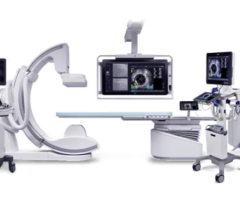
March 20, 2012 – The Society for Cardiovascular Angiography and Interventions (SCAI) published a first-of-its-kind paper defining best practices in the cardiac catheterization laboratory, commonly referred to as the cath lab. The paper is part of SCAI’s ongoing effort aimed to ensure the highest quality care and safety for patients undergoing interventional cardiology procedures such as angioplasty and stenting (also known as percutaneous coronary intervention or PCI). Titled “Clinical Expert Consensus Statement on Best Practices in the Cardiac Catheterization Laboratory,” the paper is e-published in Catheterization and Cardiovascular Interventions.
Just as a surgical suite serves patients requiring surgery, cath labs support procedures that require catheterization, whereby a small, flexible tube called a catheter is inserted into an artery in the patient’s upper leg or wrist to access the heart arteries and clear blockages. The cath lab is where heart attacks are stopped and where patients suffering from various forms of heart disease are treated for symptom relief and improvements in quality of life.
“Interventional cardiologists are guided by a number of quality improvement tools, including guidelines and appropriate use criteria, but consensus opinion on best practices for how to run these cath labs has been missing until now,” said Srihari S. Naidu, M.D., FSCAI, SCAI trustee and director of the cardiac catheterization laboratory at Winthrop University Hospital, Long Island, NY, and lead author of the paper. “This paper represents the most current, evidence-based approach to continually improving the safety and care of interventional cardiology patients in cath labs across the country and the world.”
The paper published recommends best practices that should be upheld by interventional cardiologists and other medical staff performing procedures in the cath lab setting. The best practices are divided into three categories: before the procedure, during and after the procedure, including follow-up evaluation, and feature the following highlights:
- Assembling an optimal cardiac catheterization team. Physicians should maintain proper credentialing and other members of the medical staff should also have the proper certifications and experience. In addition, procedure outcomes, including success rates and observed complications, should be documented.
- A pre-procedure checklist for cardiac catheterization that guides the attending physician through a list of questions to review and verify prior to initiating the procedure. A common tool used in other medical specialties, the checklist includes affirmation of the procedure type, pre-catheterization assessments, as well as reviewing the patient’s health history, ability to adhere to medication regimens, informed consent, sedation, and allergies.
- Receiving informed consent. Included within pre-procedure best practices is the importance of receiving informed consent from the patient, ideally with a third-party witness. The paper points out the importance of verifying the patient fully understands what the procedure entails; the risks, benefits and alternatives to the treatment proposed; as well as potential outcomes and complications that may occur during and after the procedure.
- A recommended “time out” protocol to be performed immediately before the procedure and when all members of the medical team are present. During this “time out” period, patient identification is verified, as is procedure route, procedure equipment, patient allergies and special medical conditions.
- Patient preparation in the procedure room. Best practices during the procedure include a thorough review of the patient’s medical record, access site concerns, allergies, blood test results, recent medications, advance directives, informed consent and living wills.
- Appropriate post-procedure communications and evaluation. Following the procedure, the patient must be carefully monitored during the hospital stay. The physician should discuss the results of the procedure, as well as complications, unexpected findings and events with the patient and family as well as with the healthcare providers who will assume care of the patient. The physician should also explain the important role of patient adherence with prescribed medications.
- Planned follow up. Best post-procedure practices include scheduling the patient’s follow-up appointment two to four weeks after discharge to confirm the access site is healing, ascertain that there are no medication complications or problems with adherence, evaluate current lifestyle limitations and enroll in cardiac rehabilitation.
- Quality assurance protocols. Each cardiac cath lab should have processes in place for nonbiased, education-based peer review of procedures. “SCAI’s commitment to quality improvement is unwavering, and we are confident this paper will only serve to improve cath labs and the work we do for our patients,” said Christopher J. White, M.D., FSCAI, SCAI president and professor and system chairman of cardiovascular diseases at the John Ochsner Heart & Vascular Institute, New Orleans, La. “This paper will provide a benchmark for cath labs to base their current practices on and help set future goals elevating the standard of patient care across the practice.”
“Clinical Expert Consensus Statement on Best Practices in the Cardiac Catheterization Laboratory,” along with the full issue of Catheterization and Cardiovascular Interventions, is available via www.scai.org.


 December 20, 2023
December 20, 2023 








